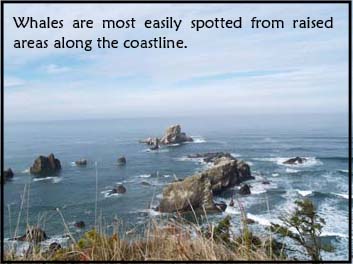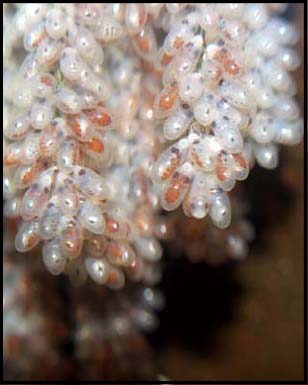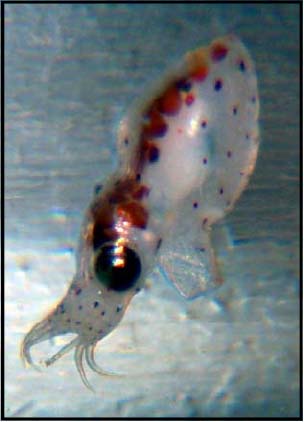|
Whale Watching Spoken Here
Every winter, gray
whales make the trek from Alaska to
Baja California to give birth. They
pass by the Oregon Coast in late December
 in a rush to warmer waters.
Once their babies are born, they
travel back to Alaska at a more leisurely pace.
Volunteers at various points along the Oregon Coast
help visitors to view gray whales during
their peak travel
times. During the weeks of December 26-January 1 and
March 24-31, volunteers will be at Ecola State Park and
at Neahkahnie Mountain to answer your questions and
keep track of whale sightings. For more information or
to volunteer, visit the website at
www.whalewatchspokenhere.org
in a rush to warmer waters.
Once their babies are born, they
travel back to Alaska at a more leisurely pace.
Volunteers at various points along the Oregon Coast
help visitors to view gray whales during
their peak travel
times. During the weeks of December 26-January 1 and
March 24-31, volunteers will be at Ecola State Park and
at Neahkahnie Mountain to answer your questions and
keep track of whale sightings. For more information or
to volunteer, visit the website at
www.whalewatchspokenhere.org
|
|
Important Winter Beach Safety
Winter is a great time for beachcombing and enjoying
winter storms, but the ocean becomes even more powerful
with strong winds and weather. Please follow these safety
tips to make your visit a pleasant one:
1. Never turn your back on the ocean.
Sneaker wavers are very powerful, sometimes strong
enough to knock over an adult.
2. Avoid logs in the surf.
They may look stable, but the ocean can roll logs over you.
3. This is not a safe area for swimming
in the ocean. Be aware there is a strong undercurrent.
4. Completely extinguish your campfires.
Embers can burn for days if left or covered.
5. Leave marine mammals alone.
Marine mammals can carry diseases transmutable to humans and pets.
|
|
Baby Octopuses a Rare Sight

It sometimes pays to examine closely tanks that at first glance look empty. This winter
an octopus on the east wall laid eggs which hatched hundreds, if not thousands, of
baby octopuses. Octopus rubescens, commonly known as red octopus, are much smaller than the more
 widely recognized Giant Pacific octopus. The one in the east tank is sometimes
difficult to see; she is the size of an adultís hand and can hide in very tight spaces.
When she laid a cluster of eggs between a rock and the
tank glass, she guarded them closely, aerating them
around the clock. Visitors and staff were able to see the
mom and egg cluster so well, they could even discern
eyes in the eggs. An octopus lays 500 to 3,000
eggs only once in its lifetime, sheltering the eggs and
refusing to eat. Soon after the babies have hatched, the mother dies.
Babies started hatching in early December and continued
hatching for a couple of weeks. Slightly larger than a head of a pin and barely visible to
the naked eye, the translucent babies swam in the gravel and throughout the tank. The
babies have been released into intertidal areas where their chances of survival were
greater than in our tanks that constantly circulate fresh water and might flush such
small creatures through the system. The opportunity to see this unique display will end
when all of the babies have hatched and the mother dies; but keep looking in the tanks.
There are always exciting things for the careful viewer to find.
widely recognized Giant Pacific octopus. The one in the east tank is sometimes
difficult to see; she is the size of an adultís hand and can hide in very tight spaces.
When she laid a cluster of eggs between a rock and the
tank glass, she guarded them closely, aerating them
around the clock. Visitors and staff were able to see the
mom and egg cluster so well, they could even discern
eyes in the eggs. An octopus lays 500 to 3,000
eggs only once in its lifetime, sheltering the eggs and
refusing to eat. Soon after the babies have hatched, the mother dies.
Babies started hatching in early December and continued
hatching for a couple of weeks. Slightly larger than a head of a pin and barely visible to
the naked eye, the translucent babies swam in the gravel and throughout the tank. The
babies have been released into intertidal areas where their chances of survival were
greater than in our tanks that constantly circulate fresh water and might flush such
small creatures through the system. The opportunity to see this unique display will end
when all of the babies have hatched and the mother dies; but keep looking in the tanks.
There are always exciting things for the careful viewer to find.
Seaside Aquarium Owners: Kathe Baldwin and Jerome Ives
Aquarium Board Members: Kathe Baldwin, Jenne Baldwin, Keith Chandler,
Jim Clune, Jerome Ives, John Ives, and Neal Maine.
Photos by: Tiffany Boothe
 in a rush to warmer waters.
Once their babies are born, they
travel back to Alaska at a more leisurely pace.
Volunteers at various points along the Oregon Coast
help visitors to view gray whales during
their peak travel
times. During the weeks of December 26-January 1 and
March 24-31, volunteers will be at Ecola State Park and
at Neahkahnie Mountain to answer your questions and
keep track of whale sightings. For more information or
to volunteer, visit the website at
www.whalewatchspokenhere.org
in a rush to warmer waters.
Once their babies are born, they
travel back to Alaska at a more leisurely pace.
Volunteers at various points along the Oregon Coast
help visitors to view gray whales during
their peak travel
times. During the weeks of December 26-January 1 and
March 24-31, volunteers will be at Ecola State Park and
at Neahkahnie Mountain to answer your questions and
keep track of whale sightings. For more information or
to volunteer, visit the website at
www.whalewatchspokenhere.org

 widely recognized Giant Pacific octopus. The one in the east tank is sometimes
difficult to see; she is the size of an adultís hand and can hide in very tight spaces.
When she laid a cluster of eggs between a rock and the
tank glass, she guarded them closely, aerating them
around the clock. Visitors and staff were able to see the
mom and egg cluster so well, they could even discern
eyes in the eggs. An octopus lays 500 to 3,000
eggs only once in its lifetime, sheltering the eggs and
refusing to eat. Soon after the babies have hatched, the mother dies.
Babies started hatching in early December and continued
hatching for a couple of weeks. Slightly larger than a head of a pin and barely visible to
the naked eye, the translucent babies swam in the gravel and throughout the tank. The
babies have been released into intertidal areas where their chances of survival were
greater than in our tanks that constantly circulate fresh water and might flush such
small creatures through the system. The opportunity to see this unique display will end
when all of the babies have hatched and the mother dies; but keep looking in the tanks.
There are always exciting things for the careful viewer to find.
widely recognized Giant Pacific octopus. The one in the east tank is sometimes
difficult to see; she is the size of an adultís hand and can hide in very tight spaces.
When she laid a cluster of eggs between a rock and the
tank glass, she guarded them closely, aerating them
around the clock. Visitors and staff were able to see the
mom and egg cluster so well, they could even discern
eyes in the eggs. An octopus lays 500 to 3,000
eggs only once in its lifetime, sheltering the eggs and
refusing to eat. Soon after the babies have hatched, the mother dies.
Babies started hatching in early December and continued
hatching for a couple of weeks. Slightly larger than a head of a pin and barely visible to
the naked eye, the translucent babies swam in the gravel and throughout the tank. The
babies have been released into intertidal areas where their chances of survival were
greater than in our tanks that constantly circulate fresh water and might flush such
small creatures through the system. The opportunity to see this unique display will end
when all of the babies have hatched and the mother dies; but keep looking in the tanks.
There are always exciting things for the careful viewer to find.